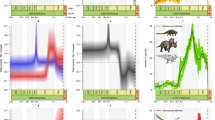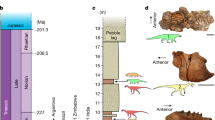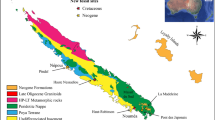Abstract
Both great dinosaurian orders (Saurischia and Ornithischia) were major components of terrestrial vertebrate faunas for ∼150 Myr. The prevailing view is that dinosaurs attained an evolutionary acme late in the Cretaceous, after which they gradually declined in taxonomic diversity over ∼10 Myr to their extinction 63 Myr ago1–6. The postulated decline is usually supported by comparing diversity levels in 76 Myr-old and 64 Myr-old dinosaurian assemblages from North America. The resulting differences in diversity have never been compared, however, with those observed between older dinosaurian assemblages, when their extinction was not imminent. I show here that, taken as a whole, the known fossil record of North American dinosaurs shows no evidence of a decline in taxonomic diversity lasting several million years or more before their extinction.
This is a preview of subscription content, access via your institution
Access options
Subscribe to this journal
Receive 51 print issues and online access
$199.00 per year
only $3.90 per issue
Buy this article
- Purchase on Springer Link
- Instant access to full article PDF
Prices may be subject to local taxes which are calculated during checkout
Similar content being viewed by others
References
Archibald, J. D. & Clemens, W. A. Am. Scient. 70, 377–385 (1982).
Bakker, R. T. in Patterns of Evolution as Illustrated by the Fossil Record (ed. Hallam, A.) 439–468 (Elsevier, Amsterdam, 1977).
Buffetaut, E. Mém. Soc. géol. Fr. 139, 47–52 (1980).
Schopf, T. J. M. Geol. Soc. Am. spec. Pap. 190, 415–422 (1982).
Rozhdestvensky, A. K. in Evolution and Change of the Organic Realm at the Mesozoic–Cenozoic Boundary (in Russian) (ed. Menner, V. V.) 57–82 (Academy of Sciences of the USSR, Moscow, 1978).
Van Valen, L. & Sloan, R. E. Evol. Theory 2, 37–64 (1977).
Colbert, E. H. Dinosaurs, their Discovery and their World, 300 (Dutton, New York, 1961).
Russell, D. A. Syllogeus (in the press).
Clemens, W. A., Lillegraven, J. A., Lindsay, E. H. & Simpson, G. G. in Mesozoic Mammals (eds Lillegraven, J. A. et al.) 7–58 (University of California Press, Berkeley, 1979).
Raup, D. M. Paleobiology 1, 333–342 (1975).
Tipper, J. C. Paleobiology 5, 423–434 (1979).
Béland, P. & Russell, D. A. Can. J. Earth Sci. 15, 1012–1024 (1978).
Russell, D. A. Terra 21, 3–9 (1983).
Dodson, P. Mosasaur 1, 89–118 (1983).
Russell, D. A. Geol. Ass. Canada spec. Pap. 13, 119–136 (1975).
Galton, P. M. & Sues, H. D. Can. J. Earth Sci. 20, 462–472 (1983).
Molnar, R. E. J. Paleont. 52, 73–82 (1978).
Molnar, R. E. J. Paleont. 54, 102–108 (1980).
Morris, W. J. Los Angeles County Mus. Contr. Sci. 193, 1–14 (1970).
Morris, W. J. in Athlon, Essays on Palaeontology in Honour of Loris Shano Russell (ed. Churcher, C. S.) 93–113 (Royal Ontario Museum, Toronto, 1976).
Gill, J. R. & Cobban, W. A. U.S. geol. Surv. prof. Pap. 776 (1973).
Jeletzky, J. A. Geol. Surv. Canada Pap. 77-18 (1978).
Frye, C. I. Bull. N. Dak. geol. Surv. 54, 65 (1969).
Sternberg, C. M. Geol. Surv. Canada Pap. 47-1 (1947).
Russell, D. A. Natn. Mus. Canada nat. Hist. Pap. 36 (1967).
Ostrom, J. H. Bull. Peabody Mus. nat. Hist. 30, 165 (1969).
Ostrom, J. H. Bull. Peabody Mus. nat. Hist. 35, 234 (1970).
Ostrom, J. H. Mus. Comp. Zool. Breviora 439 (1976).
Sues, H. D. Palaeontographica A169, 51–72 (1980).
Osmolska, H. Mém. Soc. géol. Fr. 139, 145–150 (1980).
Fox, R. C. Geol. Ass. Canada spec. Pap. 18, 577–594 (1978).
Kielan-Jaworowska, Z. & Sloan, R. E. Acta palaeont. pol. 24, 187–197 (1979).
Bonaparte, J. F. El. Mesozoico de America del Sur y sus Tetrapodes (Fundacion Miguel Lillo, Tucuman, 1978).
Taquet, P. Mém. Soc. géol. Fr. 139 (1980).
Jacobs, L. L. (ed.) Aspects of Vertebrate History, 210 (Museum of Northern Arizona Press, Flagstaff, 1980).
Russell, D. A. Geol. Soc. Am. spec. Pap. 190, 401–405 (1982).
Sepkoski, J. J. Jr, Bambach, R. K., Raup, D. M. & Valentine, J. W. Nature 293, 435–437 (1981).
Knoll, A. H., Niklas, K. J. & Tiffney, B. H. Science 206, 1400–1402 (1979).
Prothero, D. R. Bull. Am. Mus. nat. Hist. 167, 277–325 (1981).
Author information
Authors and Affiliations
Rights and permissions
About this article
Cite this article
Russell, D. The gradual decline of the dinosaurs—fact or fallacy?. Nature 307, 360–361 (1984). https://doi.org/10.1038/307360a0
Received:
Accepted:
Issue Date:
DOI: https://doi.org/10.1038/307360a0
This article is cited by
-
Dinosaur biodiversity declined well before the asteroid impact, influenced by ecological and environmental pressures
Nature Communications (2021)
-
Competition structured a Late Cretaceous megaherbivorous dinosaur assemblage
Scientific Reports (2019)
-
Der neue Katastrophismus: Fakten und Interpretation
Naturwissenschaften (1985)
Comments
By submitting a comment you agree to abide by our Terms and Community Guidelines. If you find something abusive or that does not comply with our terms or guidelines please flag it as inappropriate.



